The Importance of Sweatsavers in Skate Culture
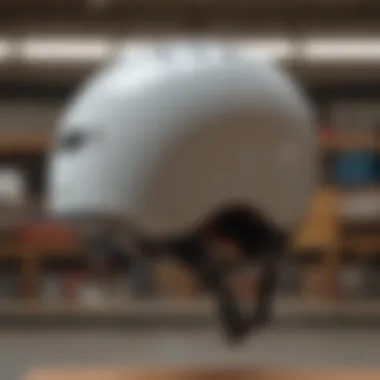
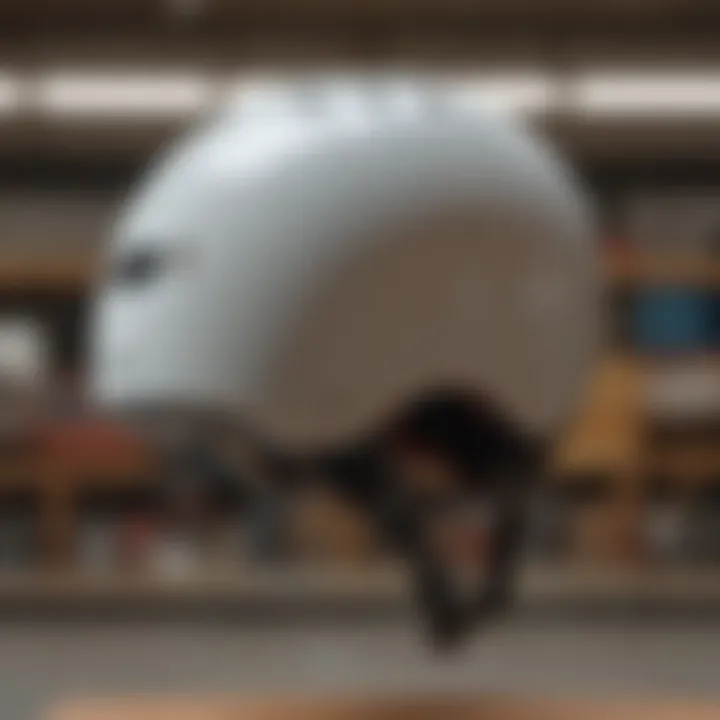
Intro
In the vibrant world of skateboarding, every skater knows that it’s not just about the board or the tricks; it’s also about the gear that keeps them safe. At the forefront of safety equipment is the sweatsaver, a versatile protective helmet that holds deep significance within the skateboarding community. These helmets have evolved not just in terms of safety but also in style and cultural relevance. This article walks through the nuanced role of sweatsavers, highlighting their functionality, cultural impact, and the critical need to step up safety measures, no matter how experienced one might be.
Techniques and Skills
Essential Tricks for Beginners
As a newbie stepping into the skateboarding scene, mastering some basic tricks can elevate your experience and confidence. Starting simple is key. Here are a few essential tricks:
- Ollie: The fundamental trick that opens the door for many others. It involves popping the tail of your skateboard, allowing the rider to hop into the air while the board follows.
- Kickflip: Once you have the ollie down, adding a flip can impress your friends. The board rotates 360 degrees on its horizontal axis as you jump.
- Grinding: Railing or curbing, grinding is when you slide along an edge, and it’s a rite of passage in skater culture.
Advanced Techniques for Pros
For seasoned skaters, the world of tricks is limitless. Here are a few advanced techniques that challenge both skill and creativity:
- Heelflip: This one flips the board using the heel rather than the toes.
- Noseslide: Sliding on the front trucks is an essential technical trick that showcases balance.
- 360 Flip: A mesmerizing combination of a kickflip and a shove-it that turns heads at the skate park.
Skateboarding Culture
The Evolution of Skateboarding
From its humble beginnings on the streets of California in the late 1950s, skateboarding has morphed into a complex cultural phenomenon. The early models were simple wooden boards, later evolving into specialized designs that cater to various styles and tricks. Skateboarding’s rise in popularity brought with it the need for protective gear, leading to the introduction of sweatsavers. This evolution reflects the growing awareness of safety in a sport known for its high risks.
Influential Skateboarders and Their Impact
Several skaters have become icons not just for their tricks but for how they’ve influenced the culture surrounding skateboarding. Individuals like Tony Hawk and Rodney Mullen have revolutionized techniques and brought skateboarding into mainstream consciousness, thereby shaping perceptions about safety gear. Their advocacy for wearing helmets has made a difference, encouraging skaters everywhere to prioritize their safety while expressing their individuality through styles and designs of their sweatsavers.
"Every trick must be attempted wearing a helmet; safety must always come first. It's not just about looking cool, it's about being cool and smart."
— An influential skateboarder
The End
It’s clear that sweatsavers are more than just helmets. They are a vital part of skateboarding culture, representing a blend of safety, style, and community spirit. As skateboarding evolves, embracing these protective gears is essential for all skaters—from enthusiastic beginners trying their first ollies to experienced professionals perfecting technical tricks.
Preamble to Sweatsavers
In the realm of skateboarding, where gravity and gravity-defying tricks dance a delicate waltz, the importance of protective gear is a topic that cannot be left in the shadows. Specifically, sweatsavers—or helmets designed for skaters—are not just a mere accessory, but pivotal instruments that intertwine safety with culture. The skateboarding lifestyle often embraces notions of freedom and rebellion, yet an equally important aspect is the responsibility of protecting one’s noggin. With that in mind, understanding sweatsavers goes beyond mere definitions; it peers into their significance within the community.
Definition and Purpose
A sweatsaver, often simply referred to as a helmet, serves to safeguard the head against impact during falls—a common occurrence in skateboarding. This gear is generally made of foam and plastic, designed to absorb shocks and prevent serious injuries, particularly concussions. Unlike biking helmets, sweatsavers are specifically tailored to withstand the unique demands of skateboarding, including the often unpredictable nature of tricks and stunts.
But the purpose of sweatsavers stretches beyond just their protective function. They also play a role in enhancing a skater's confidence. When skaters don a sweatsaver, there's an unspoken understanding that they’re both embracing adventure and prioritizing safety. This balance is crucial, especially for novice skaters who may feel hesitant about trying out new tricks.
Historical Context
Reflecting on the historical background of sweatsavers reveals the evolution of safety in skating. Initially, in the mid-20th century, helmets were not commonly seen in skate parks or on streets. They were often overlooked—a sign of weakness in a culture that prized toughness. However, a series of high-profile injuries and accidents in the late 1970s and early 1980s began to change perceptions. Influential skaters like Tony Hawk championed the use of protective gear, helping to shift the viewpoint from viewing helmets as burdens to essential safety devices.
This gradual acceptance was not without its struggles. Many skaters remained resistant, believing that wearing a sweatsaver took away from the overall experience of skating. Over time, however, the narrative began to shift. Skateboarding brands started incorporating stylish designs, catering to the artistic flair of the skater community. Today, it’s common to see helmets adorned with eye-catching graphics, reflecting personal style.
With each passing decade, the integration of sweatsavers into skateboarding culture not only marked a rise in safety awareness but also transformed how skaters view their identity. The sweatsaver became a symbol—not merely a tool for safety, but a canvas for expression and a hallmark of a responsible skater.
The Evolution of Sweatsavers
The journey of sweatsavers in skateboarding culture is as dynamic as the sport itself. Understanding how they evolved not only sheds light on their current significance but also underscores the broader cultural shifts within the skateboarding community. Initially, sweatsavers were perceived merely as protective gear; however, over time, they have become symbols of identity, safety, and even rebellion. This section delves into the pivotal changes that have shaped these helmets and emphasizes their importance for skaters today.
Early Designs and Influence
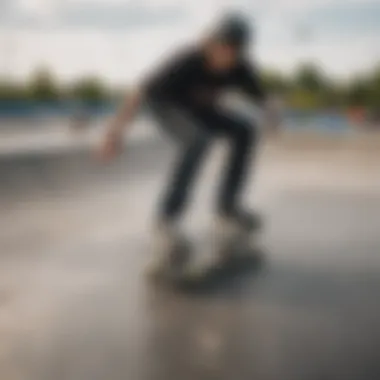

In the early days of skateboarding, the designs of sweatsavers were rudimentary at best. Most helmets were adapted from other sports, lacking specific features that catered to the unique demands of skating. Simple foam structures were standard, often offering minimal protection. Riders took risks without proper headgear or used makeshift solutions that looked more like bike helmets than what we consider a true skate helmet today.
The influence of skaters from that era can't be understated. Icons like Tony Hawk and Steve Caballero sometimes rode without them, instead opting for a fearlessness that became part of the skate ethos. Still, as injuries piled up, so did the realization of the need for better head protection. Gradually, skaters began to seek out helmets that provided more than just a barrier against the ground. It was this very need that ignited innovation in design, with early brands addressing these issues by creating helmets that, while still basic, offered improved shock absorption and fit.
Modern Innovations
Fast forward to today, the innovations in sweatsavers are nothing short of remarkable. Advances in materials like polycarbonate and EPS foam have revolutionized helmet construction. Modern sweatsavers are not only lighter but also provide superior impact resistance, making them a critical component of a skater's gear.
In addition to material enhancements, designs have also adapted to accommodate personal expression through custom graphics and colors. Skateboarders now have a plethora of options that reflect their individual styles while keeping safety a priority. Noteworthy technologies, such as MIPS (Multi-directional Impact Protection System), have found their way into mainstream use, drastically improving energy dispersion during impacts.
Moreover, today's helmets often include ventilation systems that promote airflow, keeping skaters cool while they perform at their best.
"The skater of today doesn't just want to look good; they want gear that can keep up with their level of engagement in the sport."
Key Features of Sweatsavers
When we discuss sweatsavers in the context of skateboarding, it's essential to focus on what really makes them stand out. After all, it’s not just any headgear that can protect a skater; it’s the clever combinations of design, material, and safety features that matter. These features directly contribute to the safety and comfort of the skater, ensuring that while they're enjoying the adrenaline rush, they're also looking out for their well-being. Let's take a closer look at these critical aspects.
Materials and Construction
The materials used in constructing sweatsavers play an integral role in their effectiveness and longevity. Most helmets utilize high-density polyethylene (HDPE) shells, which are known for their strength and lightweight properties. The interior padding generally consists of expanded polystyrene (EPS) foam, which absorbs impact and helps prevent injuries during spills.
Additionally, many modern sweatsavers come equipped with moisture-wicking liners. This is particularly useful when skaters are putting in a long session at the park or grinding on a hot day. A helmet that can keep sweat at bay is far more comfortable than one that leaves you feeling damp and clammy.
But it doesn’t stop there. Design is also crucial. Many brands are now experimenting with multi-directional impact protection systems. For example, some helmets feature MIPS technology (Multi-directional Impact Protection System), which allows the outer shell to rotate independently. This can significantly reduce the rotational forces during a fall, giving skaters an extra layer of protection.
It’s important to not overlook fit either. A poorly fitting helmet doesn’t just compromise safety; it can also become a distraction. Thus, choosing a sweatsaver made from flexible materials that can mold to a skater’s head shape is advisable.
Safety Standards and Certifications
In the realm of skateboarding, safety standards and certifications are paramount. Helmets often meet specific standards set forth by organizations such as the American Society for Testing and Materials (ASTM) and the Snell Memorial Foundation. These certification bodies test helmets in various categories, ensuring they can withstand impacts to provide adequate protection.
- ASTM F1492: This certification is tailored for helmets used in park and freestyle skating. Helmets that meet this standard are designed to protect against impacts at various velocities, making them a must-have for serious skaters.
- CPSC: The Consumer Product Safety Commission specifies standards for all bicycle helmets, which are similarly applicable to skateboarding helmets due to their shared characteristics. Helmets correctly bearing this certification will have undergone rigorous testing to ensure they can handle routine spills and accidents.
- EN 1078: This European standard includes helmets for cycling, skateboarding, and roller skating. Helmets meeting this standard are tested rigorously for both impact and retention system performance.
Ensuring your helmet holds these certifications isn't merely a safety formality; it signifies that the helmet has been tested under controlled circumstances to protect skaters effectively. It’s wise to check for these labels when selecting a sweatsaver, as they provide peace of mind that you’re putting your safety first.
"Wearing a helmet isn’t just about compliance; it’s a commitment to safety and well-being within the skateboarding community."
The Importance of Wearing Sweatsavers
Wearing sweatsavers is a non-negotiable aspect of skateboarding. The significance of these protective helmets extends beyond mere fashion statements, delving deep into the realms of safety and community well-being. As skaters, whether seasoned pros or enthusiastic newbies, the choice to wear a sweatsaver should be viewed as an integral part of embracing the sport—not just to look the part but to genuinely safeguard one’s health.
Preventing Injuries
Head injuries are among the most serious risks skateboarding presents. The fast-paced environment of skatin’, combined with unpredictable terrains and tricks, can lead to falls that result in concussions or worse. Sweatsavers offer a cushioned barrier that can absorb impacts, changing the odds considerably. For example, studies have shown that wearing a protective helmet can reduce the risk of severe head injuries by nearly 70%. This statistic underscores the importance of having a solid sweatsaver on your noggin.
Spend a moment to consider the kind of tricks that skaters throw themselves into: ollies, flips, and backspins can all result in sudden spills. A slip on a rail or a simple misjudgment while landing can lead to sudden trouble, and without adequate headgear, repercussions can be disastrous. The question isn’t whether you’ll fall; it’s when. Wearing a helmet can mean the difference between participating in the sport the next day or nursing a long-term injury.
Building a Safety Culture
Beyond personal protection, using sweatsavers plays a pivotal role in shaping the culture surrounding skateboarding. When skaters choose to wear helmets, it sends a message to peers and newcomers that safety is paramount. This collective mentality fosters an environment where wearing a helmet becomes the norm rather than the exception.
- Peer Influence: Seeing your favorite skater rock a sweatsaver can lead one to reconsider their own safety choices.
- Community Events: Many skate parks and competitions now encourage or even mandate helmet use, pushing the initiative on a larger scale.
- Education: Just as skate schools teach how to ollie, they also should instill the importance of helmets, cultivating a generation of skaters who prioritize safety.
Adopting a health-first mentality shapes not only individual attitudes but also impacts future generations of skaters. Young kids witness the culture of their older counterparts, understanding that while skating can be wild, staying safe is just as essential. Engaging with the community about helmet use promotes awareness and respects the sport as a whole—essential for its evolving dynamics.
Sweatsavers and Skateboarding Community
The intersection of sweatsavers and the skateboarding community is a rich tapestry woven with threads of safety, style, and sociocultural dynamics. At the heart of skateboarding lies a deep-rooted culture that not only values the freedom of expression but also fosters a sense of belonging among skaters. The use of sweatsavers—often seen as a somewhat contentious accessory—plays an integral role in shaping both the individual skater's experience and the overall community ethos.


Cultural Perceptions of Helmets
Skateboarding culture has long been a double-edged sword when it comes to protective gear. On one hand, there is a strong emphasis on individualism and pushing boundaries, which can sometimes cast safety gear like sweatsavers in a negative light. For some skaters, wearing a helmet might be viewed as an inconvenience or even as a sign of weakness. This perspective often leads to the perception that avoiding such gear is part of an unwritten code of bravery.
However, things are changing. More and more, skaters are starting to recognize that wearing a sweatsaver doesn't equate to diminished skill or courage. Many younger skaters, influenced by the evolving discussions around safety and mental health, view helmets as essential tools for continuing to skate without the looming worry of serious injury. This cultural shift helps foster a more inclusive environment where safety isn't just tolerated but celebrated.
Influential Skaters and Their Stance
When it comes to shaping culture, the voices of influential skaters carry a ton of weight. Take Tony Hawk, for instance. Known as one of skateboarding’s most iconic figures, Hawk has been an outspoken advocate for helmet use. He often emphasizes that safety gear is as crucial to the sport as the board itself. His high-profile stance promotes the idea that looking out for oneself while skating is not only wise but also essential for longevity in the sport.
Similarly, professional skater Lizzie Armanto has made waves in the community by promoting safety gear, particularly among women and girls. Her advocacy is vital as it sends a powerful message to younger skaters about the importance of prioritizing safety without sacrificing style. Many fans take cues from their heroes, making the visible endorsement of sweatsavers by well-respected figures a significant catalyst for change in cultural perceptions.
"Wearing a sweatsaver is not just about protecting your head; it’s about setting an example for others. It shows you care about the sport and the people around you." — Tony Hawk
Choosing the Right Sweatsaver
Selecting the right sweatsaver is not just about picking any helmet off the shelf; it’s about making a choice that balances protection, comfort, and personal style. For skaters, this decision can significantly influence their experience on the board. A proper sweatsaver ensures that while you are doing tricks, racing down hills, or just chilling at the skate park, you are protected yet free to express yourself. Investing some time in choosing the right one can make all the difference.
Fitting Guidelines
Getting the correct fit for a sweatsaver is paramount. A loose helmet can be as dangerous as not wearing one at all. To find the perfect size, follow these steps:
- Measure Your Head: Use a flexible measuring tape to get the circumference of your head about 1 inch above your eyebrows where the helmet will sit.
- Refer to Size Charts: Each brand may have a different sizing guide, so always check the recommended sizes based on your measurement.
- Try It On: If possible, try the helmet on while wearing appropriate gear. It should sit comfortably without excessive movement. A snug fit is ideal, but it shouldn’t pinch or cause discomfort.
- Check the Retention System: Adjust the chin strap until it feels secure but not too tight. You should be able to slide a finger comfortably beneath the strap.
By adhering to these fitting guidelines, skaters can enjoy wearing their sweatsaver while ensuring critical safety standards are met.
Styles and Aesthetics
Skateboarding is as much about expression as it is about the sport itself. The sweatsaver you choose can say a lot about your style, just like your board, shoes, or apparel. Here are considerations for styles and aesthetics when picking the right sweatsaver:
- Color and Design: Opt for colors or patterns that resonate with your personal vibe. Solid colors can be sleek and sophisticated, while vibrant designs can make a loud statement.
- Shape and Profile: Different brands offer a range of shapes. Some helmets are low-profile, giving a sleek look, while others may have more padding and bulk. Determine which style you feel comfortable with.
- Customisation: Some brands allow for custom designs, letting skaters represent their individuality. Think about adding stickers, paint, or decals to personalize your helmet further.
- Ventilation: Helmets now come in various styles with different ventilation options. A comfortable helmet, with good airflow, will enable longer sessions without excessive head sweat.
"A sweatsaver should not only protect your head, it should also complement your identity as a skater."
By weighing these aspects, skaters can find a sweatsaver that not only meets safety standards but also enhances their overall skateboarding style.
Maintenance and Care of Sweatsavers
For any skater, a sweatsaver is more than just an accessory; it’s a lifeline. Proper maintenance and care is crucial to ensure that this essential piece of gear performs at its best when you need it most. Not only does regular upkeep enhance the helmet's longevity, but it also sustains the safety standards that skaters rely on.
Cleaning and Upkeep
Keeping a sweatsaver clean is like maintaining a well-oiled skateboard. A dirty helmet can retain unpleasant odors and might even invite mold or bacteria growth, which can be bothersome. Basic cleaning should become part of your regular routine. Here are a few tips:
- Wipe Down After Use: Grab a damp cloth and give the inner lining a good wipe down after every session. This simple step helps remove sweat and grime that accumulate during rides.
- Use Mild Soap: If your sweatsaver is particularly grungy, a mild soap mixed with water works wonders. Make sure to rinse it thoroughly to avoid soap residue.
- Air Dry: Never use high heat to dry your helmet. Instead, allow it to air dry in a well-ventilated area. This helps maintain the helmet shape and inner materials.
- Inspect Regularly: Take a moment each time you clean it to inspect for any signs of wear and tear. Look for cracks, loose straps, or anything out of the ordinary.
In these maintenance routines, remember that care reflects on your commitment to safety.
When to Replace Your Sweatsaver
No matter how well you maintain your sweatsaver, it won't last forever. Knowing when to replace it can be as crucial as choosing the right one in the first place. Here are some signs that it’s time to hang up your old helmet:
- Visible Damage: Cracks or dents are clear indicators that your helmet may have lost its integrity. Even small signs can compromise safety, so it’s better to be safe than sorry.
- Age: Many manufacturers recommend replacing helmets every 3-5 years, even if they appear to be in decent shape. The materials can degrade over time due to environmental factors.
- After a Crash: If you take a spill and your helmet hits the ground, it's advisable to replace it—even if it looks fine. The protective foam may have compressed in ways that aren’t visible.
"A helmet can protect you from the unexpected, but once it’s been in the heat of action, its effectiveness isn't guaranteed."
- Fit Changes: As your riding style evolves, your helmet might not suit you anymore. If it feels loose or tight even after adjustments, it might be time to invest in a new sweatsaver.
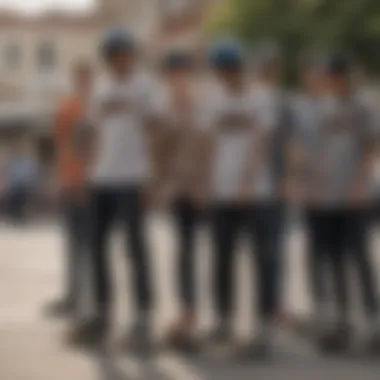
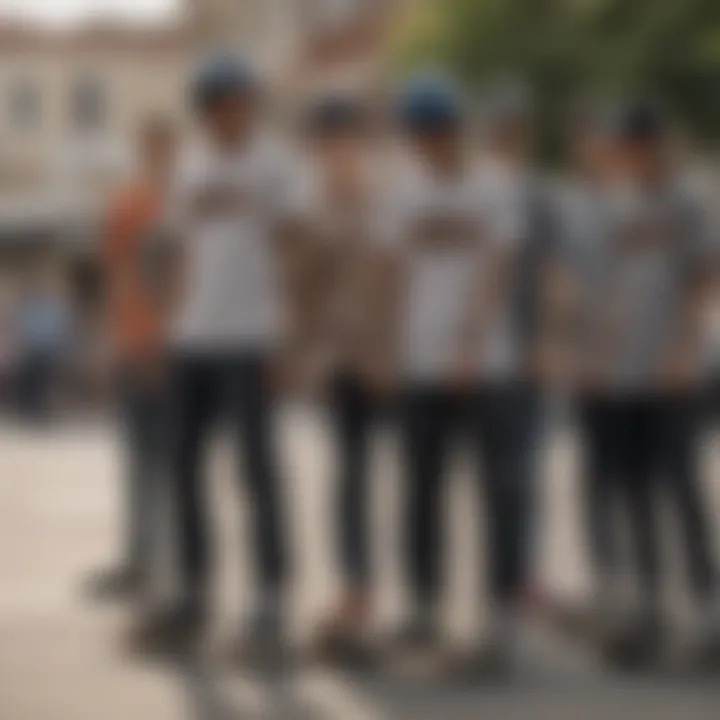
Proper maintenance and timely replacements are essential components of rider safety and should be top of mind. Investing a little effort into care and regularly checking your helmet can mean the difference between a safe ride and one that invites danger.
Case Studies: Real-World Examples
Real-world examples carry a weight that statistics and theory cannot. When discussing the significance of sweatsavers in skateboarding culture, these case studies provide tangible proof of their impact. They show how these helmets don’t just serve as protective gear; they embody a culture of safety that can save lives and influence the community positively. Let's dive into two crucial areas: injury prevention stories and community initiatives promoting safety.
Injury Prevention Stories
Consider the story of Jake, a sixteen-year-old skater from Oregon. Jake was known for his daring tricks at local parks. One fateful day, while attempting a particularly ambitious grind, he took a tumble. Thankfully, Jake wore his sweatsaver—a vibrant blue model that matched his skateboard.
His helmet took the brunt of the impact, leading to a concussion but sparing him from a more severe head injury.
"I can't say how grateful I am for the helmet," Jake said later. "It might look cool, but it literally saved my life."
Numerous narratives like Jake's exist in the skateboarding community. Each story emphasizes how a simple piece of equipment can change the outcome of an accident. According to a study conducted by the American Journal of Sports Medicine, the use of helmets has been associated with a 70% reduction in head injuries among skateboarders. These numbers aren’t just dry facts; they translate to countless lives spared from serious injury.
Other profound prevention stories come from organized skate events aiming to highlight the importance of helmet use. During these events, skaters share their personal experiences, encouraging younger skaters to embrace safety gear. This camaraderie not only strengthens community bonds but also promotes an ethos where safety becomes a shared responsibility.
Community Initiatives Promoting Safety
Initiatives to promote helmet use are present across many skateboarding scenes, often spearheaded by local advocacy groups or even the skaters themselves. An illustrative initiative is the "Save Our Skaters" campaign in San Francisco. This program focuses on education, providing workshops that teach skaters about the risks of not wearing a helmet and showcasing success stories like Jake's.
In addition to education, the campaign also offers helmet giveaways to skaters who attend workshops, ensuring that cost isn't a barrier to safety. This back-and-forth engagement builds a culture where helmet usage is normalized, rather than stigmatized.
As another example, the community-run project "Skate Safe" in New York offers free monthly clinics where experienced skaters coach newcomers, all while stressing the importance of wearing a helmet. When these seasoned skaters share their own experiences with injuries and safety gear, the message lands more effectively. Young skaters are more likely to listen when the advice comes from those they look up to.
Through these initiatives, we see that the mission of promoting sweatsavers goes beyond individual safety. It fosters a communal mindset that invites all skaters to be a part of a protective circle. When the culture shifts from one of recklessness to conscientiousness, every skater stands a better chance of riding another day—no matter how gnarly the tricks get.
Future Trends in Sweatsavers
As skateboarding continues to morph and adapt, so too do the tools and equipment that accompany it. Sweatsavers are no exception, as they evolve in tandem with the skateboarding culture. Understanding these future trends is crucial, not only for safety but also for maintaining a culture that embraces innovation without losing its core values.
Technological Advancements
The realm of technology is marching ahead at an alarming rate, and it's making its way into the world of skatesavers like a skateboarder effortlessly gliding down a smooth pavement. Innovations in materials are paving the way for helmets that are lighter yet stronger than ever. For instance, manufacturers increasingly incorporate materials like expanded polypropylene (EPP) and new types of foam that can absorb more impact, giving skaters a confidence boost while they shred.
- 3D Printing: One significant advancement is the rise of 3D printing. This technology allows for custom-fitted helmets tailored to individual head shapes. Imagine how that could make the whole experience more comfortable and better fitting, reducing distractions while performing stunts!
- Integrated Technology: Trends are also swinging towards helmets with integrated technologies. Some helmets now come with built-in Bluetooth speakers and microphones, allowing skaters to jam out and stay connected with friends, which can also be a boon for safety in group settings.
- Enhanced Ventilation Systems: Riders can often sweat a lot during intense sessions, and innovative ventilation systems improve comfort. Airflow designs promote cooling without compromising on protection.
These advancements underscore a commitment to safety and performance, aligning well with the future of skateboarding as a sport and lifestyle.
Shifting Attitudes Toward Safety Gear
The cultural perception of safety gear is slowly, but surely, changing among skaters. Unquestionably, it still carries some stigma, sometimes considered a sign of weakness or lack of skill. However, a marked shift is underway as skaters recognize that safety is not just about caution; it’s a badge of honor. This understanding is vital as it cultivates a responsible mindset within the community.
- Community Leaders and Role Models: Influential skaters are beginning to wear sweatsavers more publicly, actively promoting their use. Whether it's at competitions or casual skate sessions, these leaders signal to younger skaters that protecting oneself is cool.
- Education and Awareness Campaigns: Community initiatives are also increasing awareness about the importance of wearing sweatsavers. Workshops and local events emphasize safety alongside skills development, reshaping attitudes from the grassroots level.
- Cultural Integration in Skate Fashion: Fashion trends are increasingly incorporating helmets as style statements. Helmets that blend aesthetics with function are cropping up in skate shops, making it easier for the wardrobe to align with safety choices. Modern designs come in various colors and patterns, catering to personal styles without compromising safety.
In summary, as technology advances and attitudes evolve, sweatsavers will reflect the spirit of modern skate culture. Embracing these changes can help skaters not only protect themselves but also foster a community that values safety and style.
Epilogue
The role of sweatsavers in skateboarding culture cannot be underestimated. As skaters, we inhabit a world filled with thrills and spills, where the need for safety gear is clear yet sometimes overlooked. In this article, we've taken a closer look at sweatsavers, not just as protective gear but as a cultural emblem that resonates with the skateboarding community.
Recap of Sweatsavers' Importance
Sweatsavers, or helmets as many call them, offer more than just a cushion for the head. They act as a barrier between the rider's joy and the harsh reality of pavement encounters. The essentials include:
- Injury Prevention: Research shows that wearing a proper sweatsaver reduces the risk of severe head injuries by significant margins. Stats indicate that those who don helmets during tricks have 70% fewer serious head traumas than those who don't.
- Cultural Relevance: Helmets symbolize a shift in skateboard culture. The emergence of stylish and functional designs has changed perceptions around wearing them. No longer just plain, bulky equipment, modern sweatsavers blend seamlessly into the aesthetic of skater identity.
- Community Support: The skateboard community increasingly embraces safety. Influential skaters advocate for helmet use, promoting a broader culture of safety over recklessness. This shift in behavior makes helmets not just an item of safety, but also a badge of honor.
Call to Action for Skaters
The ultimate message is clear: If you're a skater, prioritize your safety. Consider the following actions:
- Wear Your Sweatsaver: Make it a non-negotiable part of your skateboarding experience. Regardless of your skill level, accidents can happen.
- Choose Wisely: Invest in a sweatsaver that fits well and complements your style. Don't shy away from experimenting with different designs to find that perfect match.
- Spread Awareness: Educate fellow skaters, especially newcomers, about the nuances of helmet safety. Encourage them to view sweatsavers as an essential part of their skateboarding journey, not just another form of gear.
In closing, wearing a sweatsaver is more than just putting on a helmet; it's about embracing a culture of safety and responsibility while enjoying the thrills that skateboarding offers. Let’s look out for each other and keep pushing boundaries safely.







